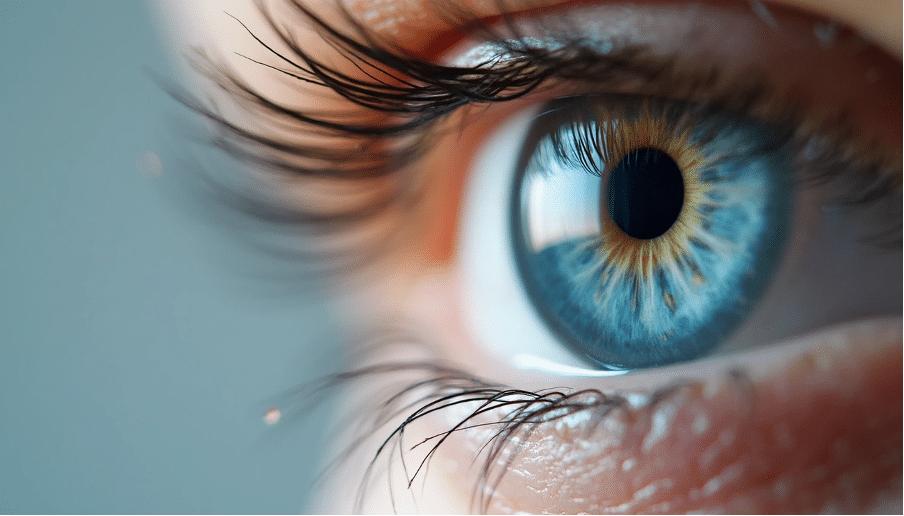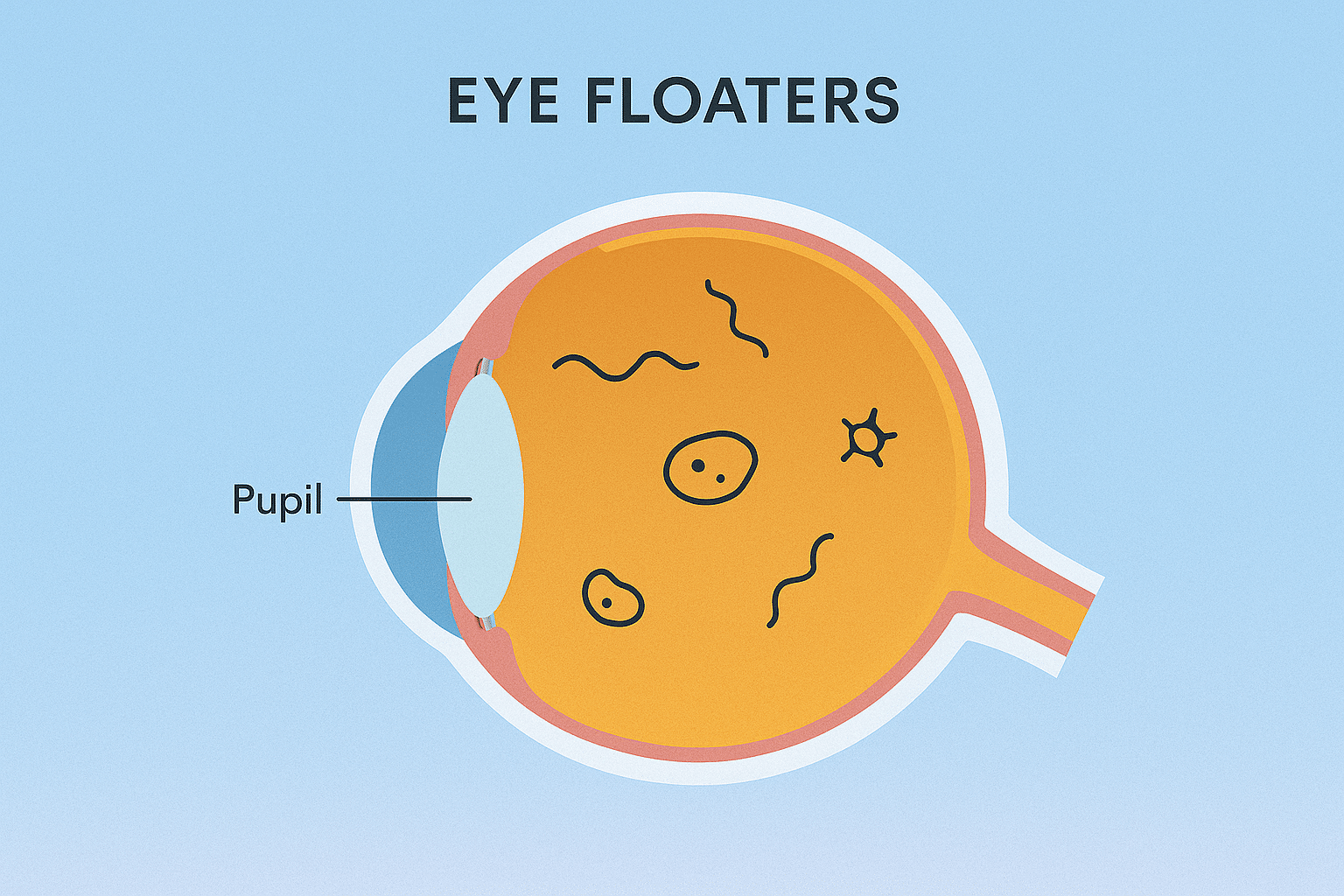You might wonder if cataract surgery can get rid of floaters. The question becomes even more relevant if you’re part of the 42% of people aged 75-79 in the UK who deal with vision-impairing cataracts. More than half of Americans aged over seventy-five have cataracts, which ranks among the leading causes of blindness worldwide.
Cataract surgery stands as the UK’s most common elective surgical procedure, but it usually doesn’t eliminate existing floaters. Many patients actually notice their eye floaters more after the surgery. The good news is these floaters tend to go away quickly. Some floaters might need a specialist’s attention, especially if they point to serious issues like a retina’s tear or hole.
Let’s explore why floaters happen, how they affect your surgery eligibility, and what changes you can expect afterward. We’ll also help you understand the right time to get professional help for floaters that won’t go away. Today’s advanced technology and expert surgical care can help you see clearly again.

What are floaters and why do they appear?
Eye floaters look like small specks, lines, or cobweb-like shadows that drift across your vision. You’ll notice them most when looking at bright, plain backgrounds such as a blue sky or white wall. Many people see these floating shapes but don’t know what causes them.
How floaters form in the vitreous
The back of your eye contains a clear, gel-like substance called the vitreous humour. Your eye’s gel changes its consistency as you age – some parts become more liquid while others stay solid. Tiny collagen fibres within the vitreous start to clump together. These clumps cast shadows on your retina that you see as floating shapes.
Posterior vitreous detachment (PVD) causes most floaters. This happens when the vitreous gel pulls away from the retina. The process usually occurs between ages 50 and 75. People with nearsightedness or those who have had cataract surgery are more likely to experience floaters.
Common symptoms and visual effects
Floaters can take several forms:
- Small dark dots or specks
- Squiggly lines or threadlike strands
- Ring-shaped or cobweb-like patterns
- Shadowy shapes that move with eye movement
These visual disturbances drift as your eyes move but seem to float away when you try to look directly at them. You might notice them more after looking at something bright or stepping outside from indoors.
Are floaters always harmless?
About 30% of people notice eye floaters. Most cases are just an annoying but harmless part of getting older. In spite of that, floaters sometimes point to more serious eye conditions that need immediate medical attention.
Watch out for a sudden increase in floaters, especially if you see flashes of light too. This could mean you have a retinal tear or detachment. These problems happen when the shrinking vitreous pulls too hard on the retina instead of separating smoothly. Eye injuries, inflammation, diabetic retinopathy, or even eye tumours can also cause floaters in rare cases.
The good news is that most floaters become less noticeable over time as your brain learns to tune them out. If persistent floaters affect your quality of life, you have several treatment options, which we’ll explore later in this piece.
Can you have cataract surgery if you have floaters?

You can still have cataract surgery even if you have floaters. A detailed evaluation before treatment will give the best results.
Why a retinal exam is essential
“The retinal exam is an essential component of any anterior segment surgery,” leading eye specialists point out. We examined patients to identify any mechanisms that could affect surgical success. Dense cataracts make it hard to see the back of the eye. Doctors sometimes need ultrasound to find potential retinal detachments, tears, or—rarely—tumours. Advanced diagnostic technologies like Optical Coherence Tomography (OCT) have become valuable tools for pre-surgical assessment. These tools can detect tiny macular changes that doctors can’t see during standard clinical examinations.
When floaters signal a more serious issue
Most floaters don’t cause harm, but they sometimes point to serious conditions that need immediate care. People who see flashes and floaters should get their retinas fully examined to check for possible holes or tears. Some warning signs need urgent medical attention: a sudden burst of new floaters, light flashes in the same eye as floaters, or a grey curtain blocking vision. These symptoms might indicate a retinal tear or detachment. Without quick treatment, these conditions could cause permanent vision loss.
How floaters affect surgical planning
Your surgeon needs to find what causes your floaters before scheduling cataract surgery. Your doctor should tell you that floaters will likely stay even after surgery. The procedure doesn’t affect floaters that exist in the vitreous cavity. Patients with retinal issues need a clear treatment priority list. Some conditions like diabetic retinopathy might get worse after cataract surgery, even without pre-surgical macular oedema. Some surgeons wait to do cataract surgery until they’ve taken care of retinal problems, especially when vision tests don’t match examination findings. A detailed pre-surgical assessment helps set realistic expectations about results after surgery and creates proper treatment plans for complex cases.
Does cataract surgery get rid of floaters?
The simple answer is no, cataract surgery does not get rid of floaters. Many patients actually notice their floaters more clearly after the procedure.

Why floaters may seem worse after surgery
Patients often become more aware of floaters after cataract surgery. Your vision becomes clearer once the surgeon replaces the cloudy lens, which makes pre-existing floaters more visible that were previously hidden by your cataract. A recent survey shows that 76% of people experience visual symptoms from floaters. The surgery itself might create new floaters because eye manipulation during the procedure can cause the vitreous gel to separate from the retina, known as posterior vitreous detachment (PVD).
Understanding the role of the intraocular lens (IOL)
The physical dynamics in your eye change when the surgeon replaces your natural lens with an intraocular lens (IOL). A cataract-affected lens usually appears more swollen than a healthy one. Existing floaters become more noticeable after its removal and replacement with a slimmer IOL because the vitreous fluid has extra space to move. This becomes especially important for patients with premium IOLs who expect perfect vision. Floaters have emerged as a common source of dissatisfaction among patients who achieve 20/20 vision but remain unhappy with their surgical outcome.
Floaters 2 years after cataract surgery: what to expect
Most patients find their floaters less bothersome as time passes. Three factors contribute to this improvement: floaters gradually drift forward in the eye away from the focal plane, sink below the visual axis, and your brain’s natural 3D depth perception helps philtre them out. Treatment options exist if floaters still bother you two years after surgery. Still seeing floaters after cataract surgery or unsure what to expect? Book a consultation with our specialists at Precision Vision London to expert guidance and personalised care.
Note that while most post-surgical floaters pose no harm, certain symptoms need immediate medical attention. These include a sudden increase in floaters, flashes of light, or shadows in your peripheral vision.
What are the treatment options for floaters after cataract surgery?
Treatment options for bothersome floaters after cataract surgery include everything from simple observation to specialised procedures. Most floaters become less noticeable over time, but some cases need a doctor’s help.
When to seek help for persistent floaters
Your eye doctor needs to know right away if you notice:
- A sudden increase in the number or size of floaters
- Flashes of light in your vision
- A curtain-like shadow moving across your peripheral vision
- Blurred vision or vision loss
- Severe eye pain
These symptoms might point to a retinal tear or detachment that can cause permanent vision loss without treatment. Quick diagnosis and treatment of retinal problems will give a much better outcome.
Vitrectomy: what it involves and when it’s used
Vitrectomy removes some or all of the vitreous gel from your eye and replaces it with a saline solution. This removes floaters by taking away the space where they float.
Doctors recommend vitrectomy only after a thorough eye exam and detailed discussion about its risks and benefits. The procedure works well to remove floaters but comes with risks such as:
- Less than 1% risk of retinal detachment weeks or months after surgery
- Faster cataract development in patients who haven’t had cataract surgery
- Rare but serious complications from infection or bleeding (less than 1 in 1000)
YAG laser treatment: benefits and risks
YAG laser vitreolysis breaks down floaters with focused light pulses that turn them into gas. This non-surgical approach works best on clear, centred floaters. Research shows about 90% of patients see major improvements after laser treatment. All the same, rare complications can include cataracts, retinal damage, or sudden pressure changes in the eye.
Should I worry about floaters after cataract surgery?
A few new floaters after surgery usually don’t signal problems, especially without other symptoms. Eye specialists often suggest waiting 3-6 months because your brain learns to tune out floaters naturally.
Do floaters still bother you after cataract surgery? Not sure what to expect? Let our specialists at Precision Vision London help you with personalised care and expert guidance.
Most floaters don’t cause harm, but sudden vision changes or floaters with pain or flashes need immediate attention. Quick professional help protects your eye health and gives peace of mind.
Conclusion
Understanding Floaters Before and After Cataract Surgery
Dealing with cataracts and floaters creates unique challenges to your vision health. This piece explored how these two common eye conditions relate to each other. Cataract surgery ranks among the most successful medical procedures in the world. It restores clarity and helps countless patients live better lives. But you should keep realistic expectations about your floaters.
Research shows that cataract surgery won’t get rid of existing floaters. Your improved vision clarity might make floaters more noticeable after surgery. Your brain will adapt over time and philtre out these visual disturbances naturally.
You need immediate medical attention if you notice a sudden increase in floaters. This becomes even more urgent with flashes of light or vision loss. These symptoms might point to serious issues like retinal tears or detachments that need quick treatment.
Treatment options exist if persistent floaters disrupt your daily life. YAG laser vitreolysis works well as a non-invasive approach for specific types of floaters. A vitrectomy offers a more detailed solution but comes with extra risks. Your specific situation determines the best choice after talking to an experienced specialist.
Precision Vision London’s team knows the complex ways cataracts and floaters affect your eye health. Our expert surgeons use advanced diagnostic technology with years of clinical experience. We create personalised treatment plans that work for your unique visual needs.
Don’t wait until floaters affect your quality of life by a lot. Book a detailed eye assessment now. This proactive step lets our specialists track your eye health, answer questions, and suggest the right treatments at the perfect time. Note that your vision deserves top-quality care—exactly what you’ll find at Precision Vision London.
FAQs
Q1. Does cataract surgery eliminate eye floaters? Cataract surgery does not directly remove eye floaters. In fact, some patients may notice their floaters more after surgery due to improved visual clarity. However, the perception of floaters often diminishes over time as the brain adapts.
Q2. What are the latest treatments available for eye floaters? Recent advancements include YAG laser vitreolysis, a non-invasive procedure that uses laser pulses to break up floaters. For more severe cases, vitrectomy surgery can remove the vitreous gel containing floaters. However, these treatments are only recommended for significantly bothersome floaters.
Q3. How long do floaters typically persist after cataract surgery? Floaters may seem more noticeable immediately after cataract surgery. However, most patients find that the perception of floaters diminishes within 3-6 months as the brain adapts. If floaters persist or worsen beyond this period, it’s advisable to consult an eye specialist.
Q4. When should I be concerned about floaters after cataract surgery? While some floaters are normal, you should seek immediate medical attention if you experience a sudden increase in floaters, flashes of light, a curtain-like shadow in your vision, or any sudden vision loss. These symptoms could indicate serious conditions like retinal detachment.
Q5. Can eye floaters be prevented after cataract surgery? Eye floaters cannot be entirely prevented after cataract surgery, as they are often a natural part of the ageing process. However, maintaining good overall eye health, protecting your eyes from UV radiation, and having regular eye check-ups can help minimise the risk of developing new floaters.
Authors & Reviewer
-
 Olivia: Author
Olivia: AuthorHi, I'm Olivia, a passionate writer specialising in eye care, vision health, and the latest advancements in optometry. I strive to craft informative and engaging articles that help readers make informed decisions about their eye health. With a keen eye for detail and a commitment to delivering accurate, research-backed content, I aim to educate and inspire through every piece I write.
-
 Dr. CT Pillai: Reviewer
Dr. CT Pillai: ReviewerDr. CT Pillai is a globally recognised ophthalmologist with over 30 years of experience, specialising in refractive surgery and general ophthalmology. Renowned for performing over 50,000 successful laser procedures.

